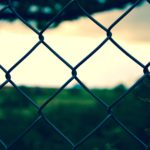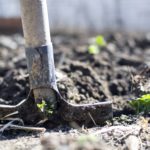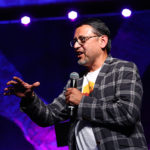CCDA’s days of learning and witness on immigration reform
When Kit Danley of Neighborhood Ministries in Phoenix, Arizona, toured the National Underground Railroad Freedom Center in Cincinnati with fellow CCDA board member Mary Nelson during the 2009 CCDA conference, she couldn’t shake a feeling of recognition. “I know this story,” she said to Nelson. “I live this story. I live it every day.”
Persecuted labor. Migrants traveling illegally at the cost of their own lives. Families torn apart. An underground network of helpers. A journey toward a great hope that never fully materializes. Travelers who can never return to the land of their birth. This was the story of the fugitive slaves. And this is the story of many immigrants in Danley’s neighborhood.
Of course, undocumented immigrants do not arrive in the U.S. as slaves. No matter how great the pressure to leave home for new opportunities, they do come of their own accord. Integrity demands that we be careful about overdrawing our analogies. But more and more people in CCDA are beginning to recognize in the undocumented journey a kindred struggle—and a struggle that demands all of our engagement.
Back at the conference, Nelson suggested to others on the CCDA board that they find a way to stand with Danley and her neighbors in Phoenix. Perhaps they could write a letter, or—“Couldn’t we have our January board meeting in Phoenix?” someone suggested.
And so it was agreed. Danley and her colleagues would host the board for a time of learning and witness. And members of the Evangelical Free Church of America board, who would also be holding meetings in Phoenix in late January, would be invited to join in.
The Border Trip
On Sunday, January 24, 2010, some 40 people boarded a bus in Phoenix to begin the two-hour trip to Tucson, where they met with the Roman Catholic bishop of the Tucson diocese and picked up speakers from the organization No Más Muertes (No More Deaths), who would ride with them to the border town of Nogales.
While the bus traveled through the desert, the speakers talked about their work of aiding undocumented travelers. They explained, Danley recalled, that “it’s dangerous and controversial to try to keep people alive” as they cross the desert. “Who cares that you traveled all this way on foot so could have a job folding laundry at [a hotel]?”
At the border wall in Nogales, Seth Polley, a border missioner with the Episcopal diocese of Arizona, led the group in a liturgy. During the lament that followed, border patrol officials ordered the group away from the wall, and they resumed their service in a parking lot nearby. “This is serious business what we’re doing,” Danley said as she recounted the story.
When the service had concluded, the group walked easily into Mexico through the Nogales main gate—so easily that some wondered why they needed to bring a passport. On the Mexico side, participants reflected on their own immigrant backgrounds and their personal stories. Then they met a young woman called Cecilia.
Cecilia had tried to cross the border a few days before. She and her companions were caught in a torrential downpour and almost drowned in a flash flood. With an injured leg and foot, Cecilia was apprehended by border guards and “dumped unceremoniously on the street” on the Mexican side, as board member Glen Kehrein recalled the story. Cecilia was now stranded and trying to decide: Should she walk 1,000 miles home? Her father had sent her north because the family has no money. He is a farmer, and no one has been buying his crops, and Cecilia’s younger siblings are hungry. Should she try to enter the U.S. again?
A few yards from where Cecilia spoke was the border wall; on it were many white crosses, placed there to honor would-be immigrants who had died on the journey.
The Witness in Phoenix—and Elsewhere
After a 90-minute wait on the Mexican side of the border gate, the group passed back into the U.S., then returned to Phoenix, watching the documentary Crossing Arizona on the way. The accumulating stories were moving participants to a new level of concern for undocumented immigrants. “Those stories touched my heart,” said board member Bob Lupton. He spoke especially of a picture of a woman, eight months pregnant, who had frozen to death while hiding in a gulley under some sagebrush. “That picture was penetrating,” he said. The pictures and stories “bring faces and names to the issue, which is very important.” Board member Craig Wong, who works with immigrants at Grace Urban Ministries in San Francisco, said that he learned more about “the physical realities of the fence and the border.” The border trip, he said, created “greater connections between the issue and the people we love” back home.
At the CCDA board meeting the next day, those who had not gone on the Sunday border trip “didn’t get why we kept flipping the channel back to immigrants,” Danley said. The board is now discussing the problem with a new sense of urgency. “We have a punitive system that doesn’t take into account the fact that businesses and people in middle-class homes are using undocumented workers who are not protected from abuse, who have no legal rights,” said board chair Barbara Williams-Skinner in an interview. Board member Glen Kehrein drew a connection with the civil rights movement: “We settled the civil rights issue legally in the 1960s and have been struggling with putting it into practice since then,” Kehrein continued, “but you have to be a citizen to benefit from those changes. These immigrants have no recourse at all.”
Resonance with the civil rights struggle came through clearly during the Day of Witness and Action on Tuesday, January 26. The day began with biblical training sessions at First Institutional Baptist Church, where Phoenix civil rights leader Warren H. Stewart is pastor. Teachers included Daniel Carroll, an Old Testament theologian from Denver Seminary and author of Christians at the Border, who discussed biblical themes of the stranger, the sojourner, and the alien living in the land; and civil rights historian Troy Jackson, who challenged the audience about evangelicals’ absence from the civil rights movement.
At lunchtime, participants visited the homes of immigrant families who shared stories of their experiences. “We’ve been helping people to be their own advocates,” Danley explained. “Without these immigrant stories we’re just smarter, but with these stories we’re changed. We’ve been with them, we’ve been in their homes, we’ve watched them cry.”
The events concluded with a time of prayer and public service at Civic Space Park in downtown Phoenix. Additional services took place in Denver, Chicago, Memphis, Miami, and Santa Ana, California. Among the speakers in Phoenix were Galen Carey, director of government affairs for the National Association of Evangelicals, and CCDA founder John Perkins, who began to cry as he finished his talk:
Providence brought me here today just to stand with my neighbor. . . . We’re at a moment in history. . . . I would want my great-grandchildren to know I was here. This is a long battle, and I won’t be here to see it end, but I wish my grandchildren would say Granddaddy was there to deal with the great justice issue of our time.





